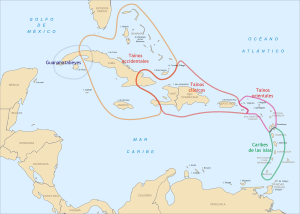Ciboney facts for kids

The Ciboney (say: See-boh-NAY), also called Siboney, were a group of Taíno people. They lived in parts of Cuba, Jamaica, Haiti, and Puerto Rico. The Ciboney were a Western Taíno group. They lived in central Cuba during the 1400s and 1500s. They had their own way of speaking and their own culture. This was different from the Classic Taíno who lived in eastern Cuba. Even so, many Ciboney lands were controlled by the eastern chiefs. In the past, some people mixed up the Ciboney with other groups. These included the Guanahatabey from western Cuba and other old cultures from around the Caribbean. But today, experts know they were different groups.
History of the Ciboney People
When the Spanish first came to the Americas, the Ciboney were the largest group in Cuba. They lived in the middle part of the island. This was between western Pinar del Río and eastern Oriente provinces. A Spanish writer named Bartolomé de las Casas lived with the Ciboney in the early 1500s. He said their language and culture were like the Lucayans from today's Bahamas.
Because of this, experts see the Ciboney as a Western Taíno group. They connect them to people from the Bahamas, Jamaica, and western Hispaniola. They are seen as different from the Classic Taíno. The Classic Taíno lived in eastern Cuba, most of Hispaniola, and Puerto Rico. Besides the Classic Taíno, the Ciboney also shared Cuba with the Guanahatabey. The Guanahatabey were an older group of people. They lived in western Pinar del Río Province. The Ciboney spoke a language called Ciboney Taíno. It was different from Classic Taíno, but people speaking both could understand each other.
The Ciboney were the main group in Cuba until about 1450. Las Casas said that the Ciboney did not have big chiefdoms or a wide political system. This was different from the Classic Taíno in the east, who were very organized. Around the mid-1400s, Classic Taíno people from Hispaniola started moving into eastern Cuba. They took over lands from the native Ciboney. These "Cuban Taíno" set up chiefdoms mostly in Oriente Province. But they also made settlements as far west as Havana.
However, the Cuban Taíno never created a political system for the whole island. This was unlike what happened in Hispaniola and Puerto Rico. More Classic Taíno moved from Hispaniola to Cuba after the Spanish arrived. Many Taíno left to escape the Spanish invasion. For example, the Hispaniola Taíno chief Hatuey ran away to Cuba with most of his people. He stayed there until the Spanish caught and killed him. After the Spanish took over Cuba in 1511, led by Diego Velázquez de Cuéllar, the number of all native groups quickly went down. By the end of that century, they had disappeared as separate groups.
Understanding the Ciboney and Guanahatabey
In the 1900s, some old writings were misunderstood. This caused experts to mix up the Ciboney with the Guanahatabey. The Guanahatabey were a nearby group. Experts also mixed them up with very old cultures around the Caribbean. Las Casas wrote about both the Ciboney and the Guanahatabey. But he made it clear they were different. The Guanahatabey were a simple society of hunter-gatherers in western Cuba. They spoke a different language that was not Taíno.
Because of this mix-up, archaeologists started using the name "Ciboney" for old places in the Caribbean where no pottery was found. Many of these places were in the land where the Guanahatabey used to live. So, the name "Ciboney" became linked to the Guanahatabey, who were not Taíno. In the 1980s, experts realized this mistake. They have now given the name "Ciboney" back to the Western Taíno people of Cuba.
See also
 In Spanish: Siboney para niños
In Spanish: Siboney para niños

